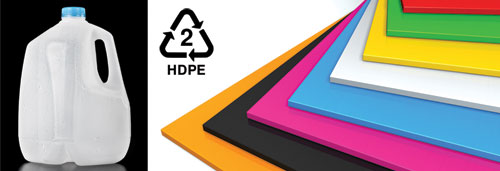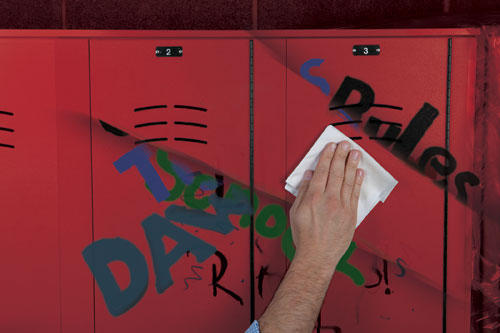School Hallway Lockers Made of High-Density Polyethylene (HDPE)
Wood Lockers
Lockers made out of wood are used in a number of higher-end settings and less often in schools, but they remain an option. They share many of the same durability issues as painted metal but don't perform as well since wood is typically more susceptible to damage from direct impacts than metal. If laminated plywood is used, that material may experience delamination if water or other liquids are able to seep between the layers. Repairing such damage is also not easy if the intent is to maintain a high level of appearance.
Perhaps the biggest issue with wood as a locker material is the fact that it is porous. That means that it will absorb and retain not only stains from water or other liquids, it will absorb odors as well. The odors can compound and create an unwelcome situation not only within a locker, but within a room or corridor where they are located. The porosity of the wood speaks of its organic nature and its ability to contribute as a food source for the growth of mold. As has commonly become recognized, mold requires three things—a food source (such as wood), moisture (such as from wet things placed into a locker), and a suitable temperature (such as conditioned indoor spaces). Since all three of these can be readily present in school situations, the likelihood of mold being present from the use of wood lockers is high unless considerable time, effort, and expense are initiated to overcome it.
Wood lockers will similarly require repainting or refinishing over time for a variety of reasons related to use, fading, wear, and tear. Their ongoing maintenance costs may well be more than metal, then, and may be quite difficult to justify. Hence wood is much less attractive and a less desirable material all around for school locker situations.
HDPE Plastic Lockers
Not all plastics are created equal. Some plastics are brittle, some are more toxic than others, and some are suitable for only certain purposes. To put HDPE in context, it is one of the most durable and commonly used plastics available and has also been found to be one of the safest. Common safe uses for this material include milk jugs, plastic bags, and yogurt cups when used in thin-layered material. In building design and construction, thicker-layered HDPE is used in the manufacture of residential composite or plastic decking, outdoor furniture, and playground equipment. It is commonly found in harsh outdoor environments such as at marinas, pools, and spas where durability and safety is needed. In fact, it is also commonly used for creating very durable bed liners in pick-up trucks and other workplace locations.
 |
|
HDPE is identified with the SPI RIC (Resin Identification Code) of 2 and comes in many formulations for household and construction uses. Image courtesy of Scranton Products |
To understand more about the life-cycle nature of plastics and HDPE in particular, we can turn to the trade association for the plastics industry known simply as SPI. They introduced the Resin Identification Code (RIC) system in 1988 at the urging of recycling proponents around the country. The RIC was developed to meet recyclers' needs while providing manufacturers with a consistent, uniform system to identify the different types of plastics that are used nationwide. Because municipal recycling programs traditionally have targeted packaging—primarily containers—the coding system offered a means of identifying the resin content of bottles and containers commonly found in the residential waste stream. The familiar embedded insignia of three arrows in a triangular shape with a number in the middle is the way that manufactured plastic items are identified using the RICs. HDPE is identified with the RIC code of number 2.
 |
The impermeable nature of HDPE surfaces means that dirt, paint, graffiti, and even stickers are removed quickly and easily. Photo courtesy of Scranton Products |
The advantages found in the various common uses of solid HDPE products apply to their use in school lockers as well. Since HDPE is inherently moisture impermeable and non-porous, lockers made of this material will never rust, corrode, or delaminate, meaning that the maintenance issues and costs associated with those problems simply are not present here. From the standpoint of general durability, an impact test conducted following ASTM standards showed that HDPE plastic lockers had 59 times greater resistance to impacts when compared to metal lockers. The nature of the material is to absorb and disperse any impact, meaning that dents are not likely and it is more resistant to abuse. Further, since the material is manufactured with solid coloring throughout, it makes scratches difficult to see, helping to retain its appearance under normal wear and tear conditions.
From a general maintenance standpoint, the qualities of HDPE that make it impermeable and non-porous mean that dirt, marker, paint, and other items don't stick to it. So, a would-be graffiti artist is quickly and readily overcome with a simple cleaning that removes anything sitting on the surface of the locker. In similar fashion, stickers, decorations, and contact paper are easily removed due to the same inherent non-permeable qualities. In the event that more thorough cleaning is needed or desired, HDPE lockers are fully able to withstand power washing and even steam cleaning. In short, worry-free maintenance is a real possibility when HDPE lockers are installed.
From an indoor environment viewpoint, using HDPE lockers in school hallways provides some clear advantages as well. Just as they are impermeable to liquids, paints, and stains, they also don't absorb odors meaning those odors aren't trapped in the locker or in the surrounding space. Further, the solid material does not act as a food source for mold or mildew, so there is no likelihood of its development. Finally, the nature of the material is to be quieter to operate and use than metal which means that noise generated in a hallway is reduced.









